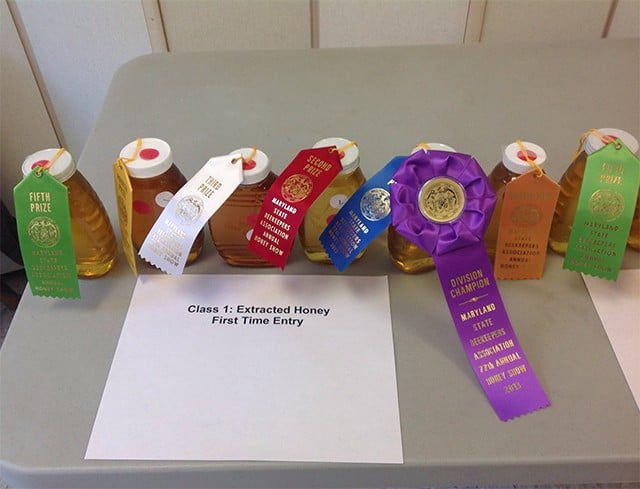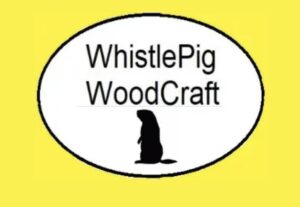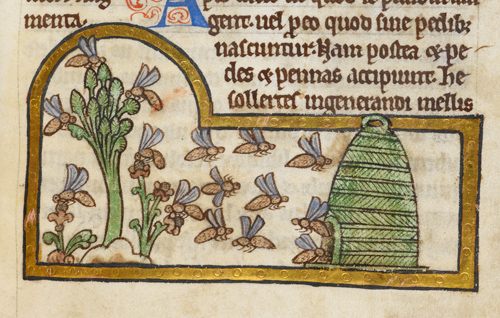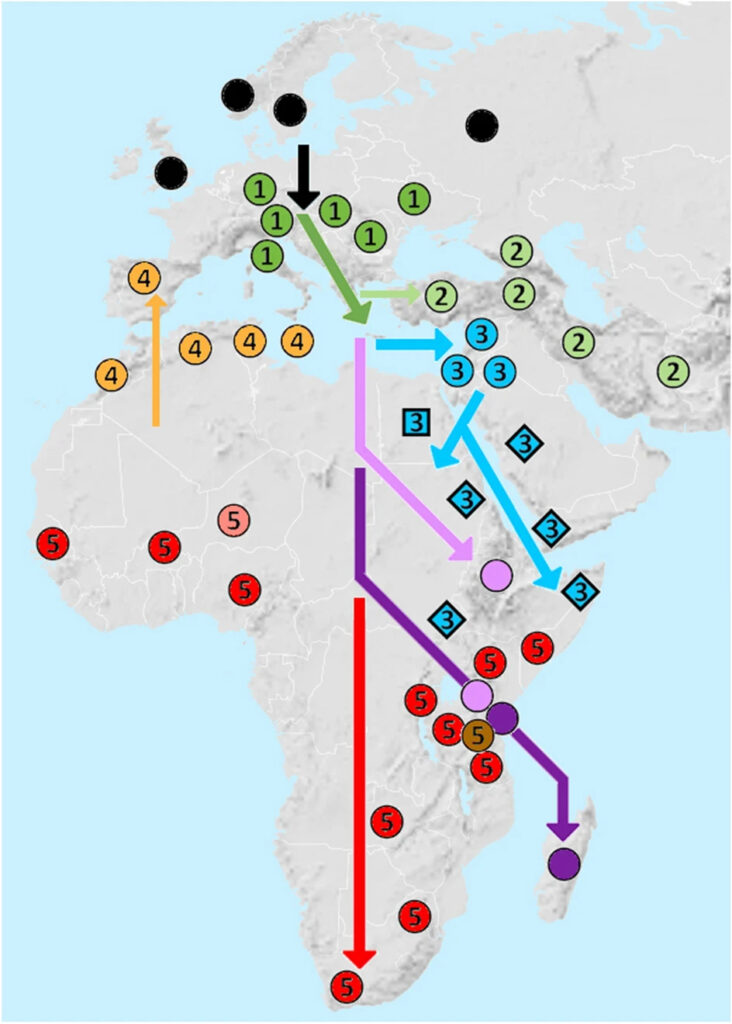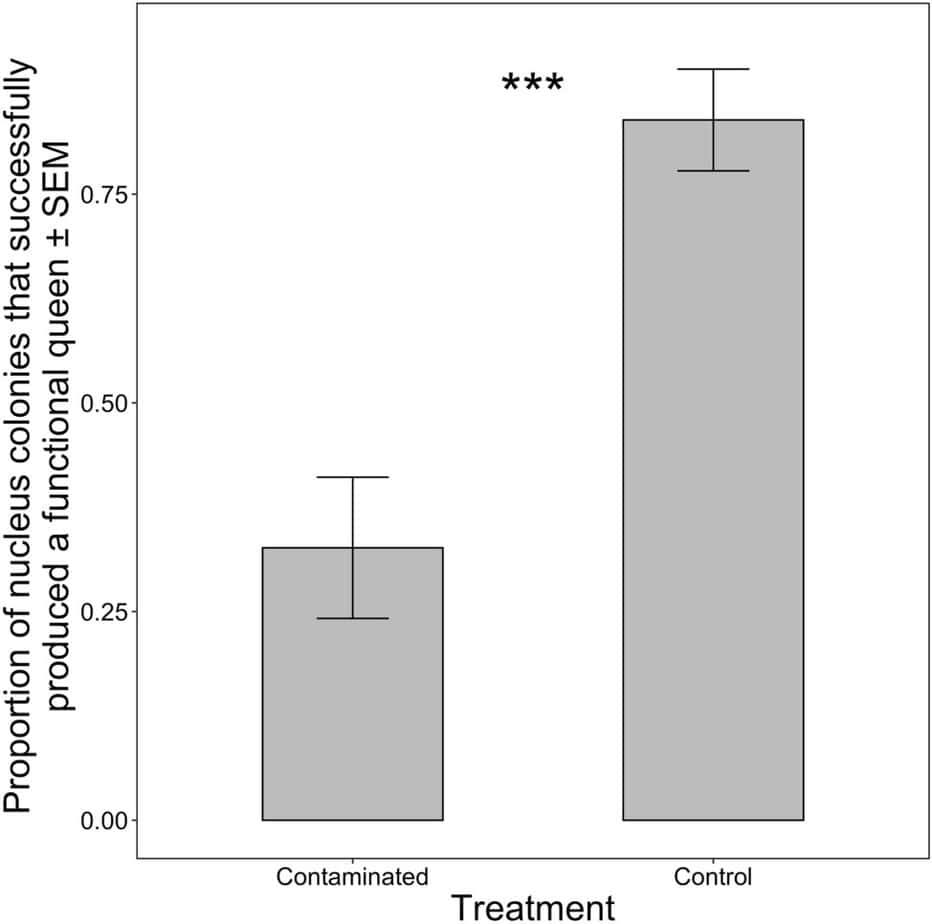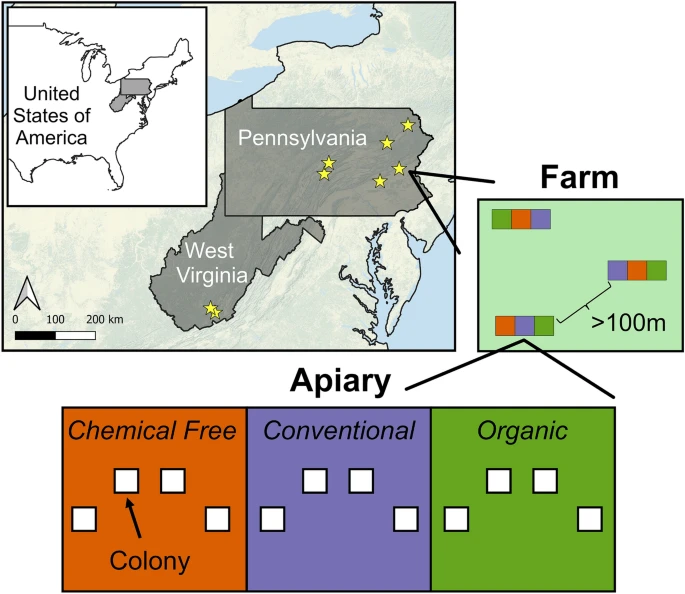
Printable edition
President's Letter
- President’s Message, November 2023
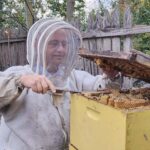
Fred inspects a hive at home.
Hello Maryland Beekeepers!
As the pollination season draws to a close, so does my time as President of MSBA. I’d like to take this last opportunity to express a few thank-yous.
Thank you to my father: C.O. Smith is and has been a prominent beekeeper in Hagerstown Valley his whole life. He recounts taking colonies to Hancock when apple orchards dotted the hillsides, and tells stories of my grandfather keeping bees in nail kegs. He would place a simple box on top of the keg for the bees to draw comb and store honey.
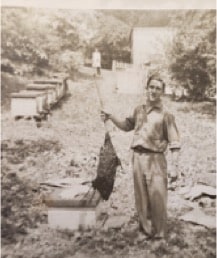
C.O. cut down this swarm and walked it a mile home. A superhero!!!
Back in those days, all the honey was then cut out and simply sold as section honey. Dad also shares stories of “taking colonies to the Eastern Shore on the ferry across the bay for FREE because you’d make a super of honey off of the cucumbers and lima beans and that was good money back then.”
My dad has certainly witnessed many changes in beekeeping. I, too, have witnessed many changes. The one constant, though, is my dad will forever be an integral part of my beekeeping. Thank you, Dad!
My own beekeeping season has been marked with typical guarantees. Fuel prices always seem so high, fruit growers take forever to pay, and swarms inevitably happen when you don’t have enough woodenware.
Along with those constants though, my affection for the bees and my commitment to service endures. Serving as the president of Maryland State Beekeepers Association is one my greatest honors. I thank you for the opportunity, and I thank you for the trust you invested in me. I would be remiss if I didn’t take this opportunity to thank a few specific individuals.
Thank you to Toni Burnham for the countless hours she puts in to keeping the MSBA ball rolling. Without Toni, my presidency would have derailed early.
Thank you to Kim Mehalick for setting me up for success, to Mary Laura for being willing to relieve me, and thank you the entire Board of Directors for their support and wisdom. I know that MSBA is in good hands for many years to come. Thank you to the many friends I’ve made through MSBA for being a part of my legacy!
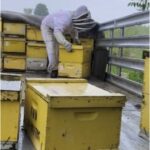
Current superhero working in the rain, bringing colonies home for winter.
For the future beekeeping family, and generation, I will offer that change is inevitable so don’t fight it. Through research, ingenuity, and a good dose of hard work those challenges will not only be overcome but may also be embraced. Giving your time, sharing your talent, or simply mentoring a new beekeeper will reward you tenfold. To adapt a few of Kennedy’s words, “ask not what MSBA can do for you, but what can you do for MSBA.”
I look forward to what the future generation of beekeeping becomes, and I thank you for it already.
Now go make sure your bees are ready for winter: and again, much thanks to all.
[Return to November 2023 BeeLine newsletter]
Letter from the Apiary Inspector
- Notes from the Apiary Inspector
-
 Spotted Lanternfly (SLF) adults are in almost every county now. Honey bees will work/forage on the Spotted Lanternfly honeydew. In some areas where SLF is plentiful the colonies were even able to gain winter weight. Some beekeepers choose to extract the fall flow for honey sales. If you are moving bees in and out of the state, please acquire a permit through the Maryland Department of Agriculture (MDA) and continue to monitor and look for egg masses on your hives and equipment.
Spotted Lanternfly (SLF) adults are in almost every county now. Honey bees will work/forage on the Spotted Lanternfly honeydew. In some areas where SLF is plentiful the colonies were even able to gain winter weight. Some beekeepers choose to extract the fall flow for honey sales. If you are moving bees in and out of the state, please acquire a permit through the Maryland Department of Agriculture (MDA) and continue to monitor and look for egg masses on your hives and equipment. -
Goldenrod could be seen all over this Fall, but did it give nectar? Due to drought in some parts of the state, it did not contribute much. I know I did not get the butterscotch/sour smell in the colonies like I have in years past. Some locations in Maryland were in a nectar dearth from August onward!
-
I am not seeing fall bee Paralytic Mite Syndrome (PMS) at the level it has been present in recent years. It appears that varroa mite management plans and more education on robbing screens may be having a positive impact! Education is the key! Also, if you have a very strong colony, still rearing high numbers of brood, a second mite treatment may be needed if the first treatment only brought the mite numbers down to threshold.
-
Some varroa treatments can cause brood death and you also want to be sure the queen is still effective after your varroa control has been removed. Check for eggs and young larvae to ensure that your colony is still queenright.
-
Calls and emails are still coming into the MDA for sightings of what people think is the "Murder Hornet." We started out the year having fielded far less "Murder Hornet" inquiries UNTIL the invasive Yellow Legged Hornet Vespa velutina was found in Georgia just outside of Savannah. We had received 27 inquiries prior to the invasive find in Georgia. Then... since the find in August we have fielded 97 inquiries about Northern Giant Hornet or Yellow Legged. Almost all were identified as Vespa crabro/European Hornet and a few were identified as Cicada killers. We do not have the Asian Giant Hornet or Yellow Legged Hornet here in Maryland and we are continuing to monitor for it.
-
Field Watch/Bee Check: This voluntary beehive mapping tool is going strong. There are more beekeepers registered than any other crop!
-
Thank you to all the beekeepers that participated in the USDA/APHIS National Honeybee Survey. We were able to complete all 24-sample sites. AGAIN, thank you to all who were willing to participate. Anyone willing to participate in 2024, please let me know. You must have 8 colonies located in the same apiary to qualify.
-
Mack and Tukka, Maryland's American Foul Brood (AFB) detection dogs, are back at work. We have been training and preparing to get back into the field, and are working on scenting and stamina now. Maryland's AFB dogs will be back into inspections as soon as the weather hits 50 degrees F and below. We will work on commercial beekeepers moving to California first.
-
If you have or are starting a beekeeping management business, or if you are being paid to apply ANY miticides to someone else's colonies, you MUST have a pesticide applicators license. KEY WORDS HERE: If you are being paid, if you do not own the bees. This does not apply to mentor/mentee relationships. This applies to Apiary management businesses.
-
We will be completing the mailing of the 2023 Apiary Registration Form in December. Please update, sign and return your registration forms as soon as possible. USPS, Scan then email, Fax... Many ways to return the form.
-
We caught 3 honey bee swarms at the port of Baltimore. The swarms of unknown origin were eradicated. We have put out swarm traps at the Port of Baltimore where the cranes load and unload the cargo freighters. The swarm traps are monitored and the lure is refreshed biweekly. Swarm traps have also been placed at the BWI Thurgood Marshall Airport. We have hung traps around the Fed Ex and the Amazon compound. The same protocol applies: we monitor and refresh the lure biweekly. We are looking for any Apis species and their parasites that may have hitched a ride on shipments.
-
Final Note: The "HUMAN" Apiary Inspectors are winding down ... but the "CANINE" Disease detectors are in training mode getting ready to start back to work.
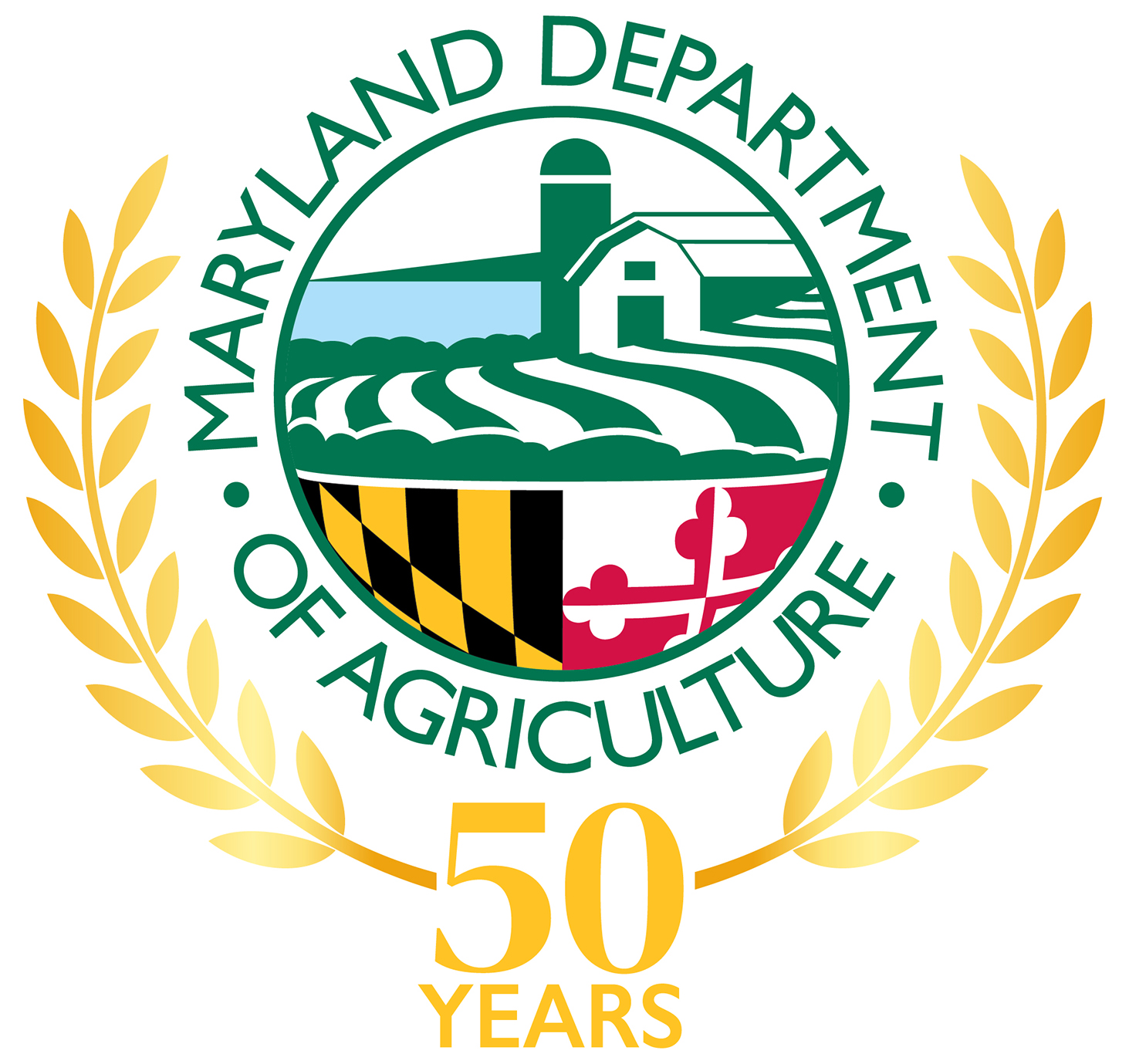
Cybil Preston
Chief Apiary Inspector
State Apiarist
EAS Certified Master Beekeeper
Certified Maryland Honey Judge
Maryland Department of Agriculture
50 Harry S. Truman Parkway
Annapolis, Maryland 21401
cybil.preston@maryland.gov
(410) 841-5920(O)
(410) 562-3464 (M)
Website[Return to November 2023 BeeLine newsletter]
-
November 11 Meeting and Elections
- 2023 November 11 MEETING
Join the Maryland State Beekeepers Association for a fascinating day packed with insights on honey bees & useful tips to keep them.
- Elections!
- Expert Speakers!
- HONEY SHOW!
- AWARDS! Free State and George Imirie
EVENT: MSBA will convene its 115 ANNUAL FALL MEETING, and 86th Honey Show.
LOCATION: Zoom AND Montgomery College Germantown Campus
ADDRESS: If attending in person: 20200 Observation Drive, Germantown, MD 20876 (SCROLL down for additional location info)You are not logged in. Please login TO VIEW THE RECORDING. Thanks!
WHERE TO BUY CANDLE MOLDS & SUPPLIES:
- Better Bee - Lyson Molds www.betterbee.com
- Blue Sky Bee Supply - Lyson Molds blueskybeesupply.com
- Mann Lake www.mannlakeltd.com
- Thorne Bee Supplies (UK) www.thorne.co.uk
- Bee Equipment (Czech Republic) beeequipment.eu
- Etsy.com and Ebay.com - Various sellers - Review shipping
- Michaels Craft Stores - limited selection
HONEY SHOW
ZOOM
When it is time (no earlier than 8:30 AM), CLICK HERE to join via zoom.
AGENDA
COMING IN PERSON? Here is more info:
The reserved spaces for the meeting are in the High Technology (HT) Building.
The main meeting room will be Globe Hall in the High Technology (HT) Building.
Adjacent spaces on the first and second floor are reserved for honey show, vendors, and catering/food.The meeting spaces are on the ground level and second floor with conveniently located elevators and restrooms on both floors.
Here is a link for a PDF map of the MC Germantown Campus: Germantown_Campus&Vicinity.pdf (montgomerycollege.edu)
Vendors, Deals and Site Info for Fall 2023 Meeting
- Vendors, Deals and Site Info for Fall 2023 Meeting
MSBA will meet for the first time at Montgomery College in Germantown (link to map and directions), and here are details you need to join us onsite! The Germantown Campus/PIC MC is located in upper Montgomery County, Maryland, just east of I-270. The reserved spaces for the meeting are in the High Technology (HT) Building. The main meeting room will be Globe Hall in the High Technology (HT) Building. Adjacent spaces on the first and second floor are reserved for honey show, vendors, and coffee/snacks.
The meeting spaces are on the ground level and second floor with conveniently located elevators and restrooms on both floors.
Dadant beekeeping supplies will be at the meeting and is offering a 10% discount on all orders that they bring to the show for our members! You must call Dadant's office at 570-980-9831 or email dadantpa2@dadant.com to get the discount. No web orders. You have the option of paying at the show er by by credit card if you call in.
Whistlepig Apiaries, local producers of beekeeping woodenware, will also be in person in Germantown! You can reach out to John Cullom of Whistlepig before the show at john@whistlepigwoodcraft.com or 443-398-0814.
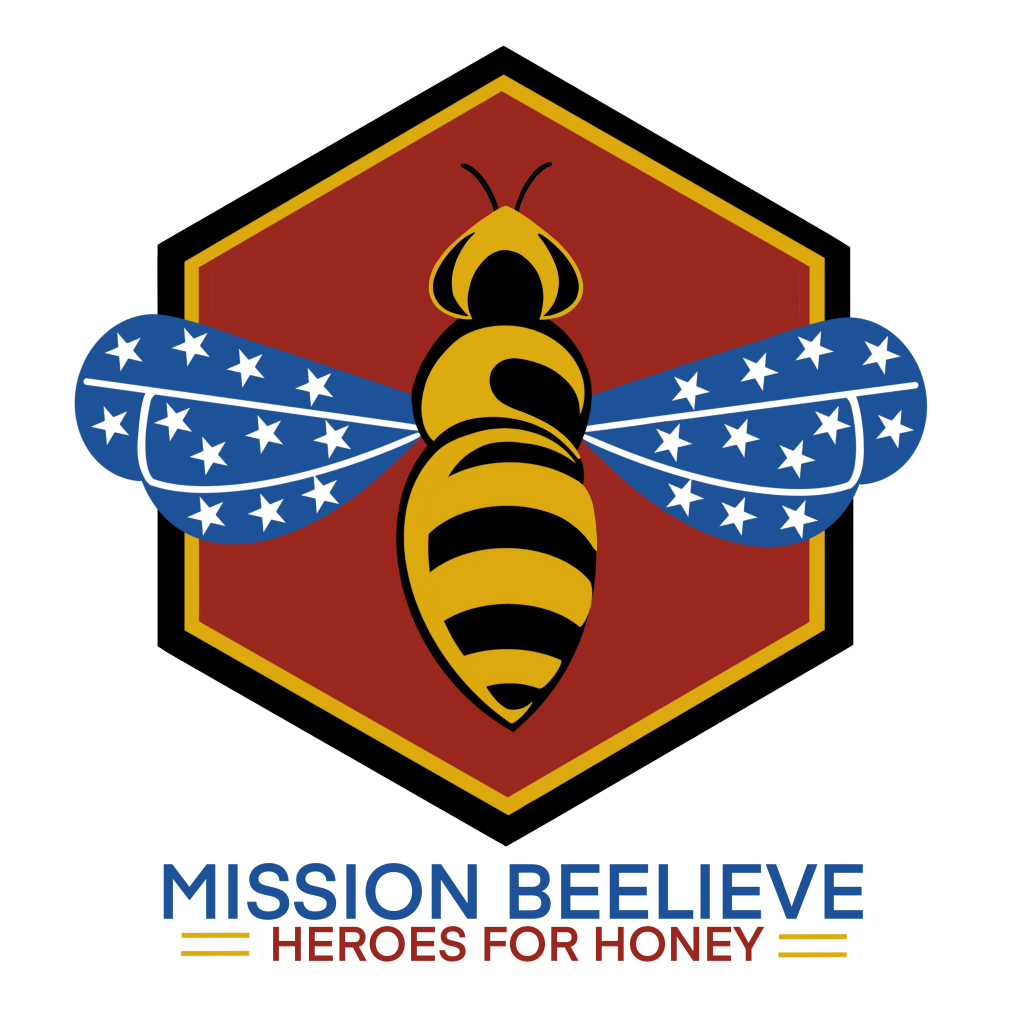
Mission Beelieve will also be at the show: Mission Beelieve is actively seeking mentors all over Maryland to support their service members. You can also apply on their website at missionbeelieve.com!
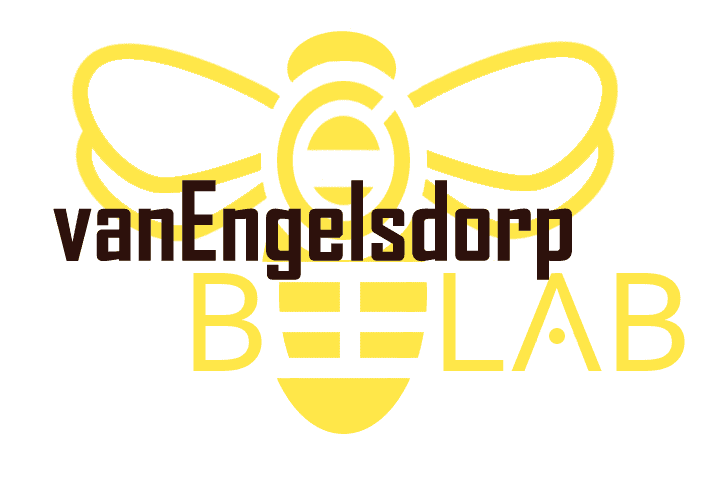
The vanEngelsdorp Bee Lab at UMD will also have a table at the Fall Meeting! Come get caught up on current Maryland research and outreach offerings critical to bee health in our region.
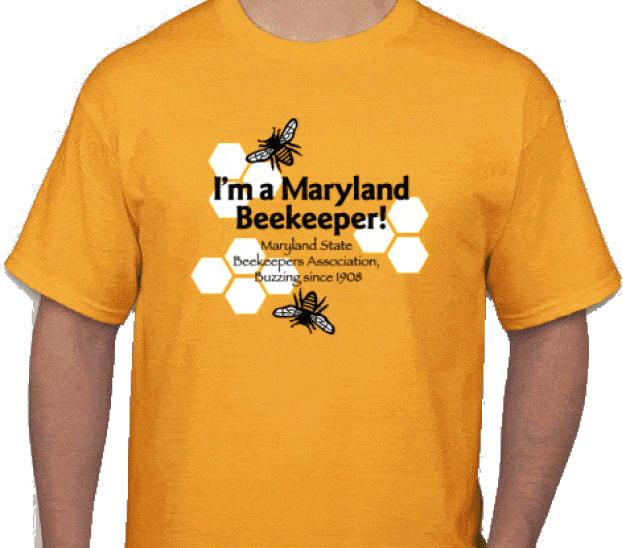
Long and short sleeved MSBA t-shirts will also be for sale at the meeting.
[Return to November 2023 BeeLine newsletter]
Telling the Bees: remembering Skip Glenn
- Telling the Bees: Clark “Skip” Glenn
Oxon Hill, Maryland beekeeper Skip Glenn will be deeply missed by all who knew him. His warm heart, zest for life, and dedication to his hobbies will be remembered fondly.
Skip had a wide range of interests and hobbies:: He was an avid cook and known for his culinary skills. He also enjoyed hunting and, in recent years, found a new passion as a beekeeper and honey farmer. He proudly named his honey "Cubby Bear Honey". Skip is survived by his loving wife, Colleen Healey and friend of over 30 years, parents Deacon Clark and Doris L. Glenn; brothers Michael Glenn, David (Dara) Glenn, Patrick Glenn, Christopher (Janka) Glenn, sister Anne Glenn-Zeljeznjak, sisters-in-laws Maureen Brown and Amy Healey (Tom Clime), nephews/nieces, Jamie Gilliam, Nathanial, Zachary, Addison, Davis, Eli, Caleb, Isaiah, Hunter, Archer and Frazier Glenn, Austin and Landon Clime, Michael Brown, Elizabeth Bobulski and a host of long life friends.
Clark L. Glenn III passed away on August 31, 2023, and a funeral service took place Saturday, October 21, 2023. In lieu of flowers, his family has requested that contributions can be made to the Maryland State Beekeepers Association, Inc.
May he rest in peace.
[Return to November 2023 BeeLine newsletter]
Yellow Legged Hornet Briefing Recording Available
- Yellow Legged Hornet Briefing Video
The recent arrival and identification of Yellow Legged Hornets (Vespa velutina) (YLH) in Georgia marks a big change in Maryland beekeepers' need to stay on top of new vespid threats! Unlike the Asian Giant Hornet (so called "murder hornet") that is not present in Maryland and coverage of which needlessly agitated the public, the arrival of YLH on the East Coast calls for community attention and action.
Cybil Preston recently presented to DCBA via Zoom with a briefing on the latest information regarding YLH and its likely arrival in our area, including identification tips, nesting behavior, impacts to bee colonies. and more. She has kindly allowed us to make the video available to you! [link]
Yellow Legged Hornets are voracious predators of pollinators, with significant interest in bee colonies. Once located, the hornets will return again and again to take returning foragers. This behavior accelerates in the late Summer and Fall with increase in the size of hornet colonies and the decline of the presence of hornet larvae (which play a role in colony nutrition). YLH may have negative impact on all native and managed pollinators, and unfortunately it increases at the time of year when it can least be sustained.
Beekeepers are being asked to learn what YLH and their nests look like, and become familiar with where to look and where to report potential sightings. The world of insects is vast, and it is easy to mistake unrelated, unthreatening species, so the time to study and prepare is now!
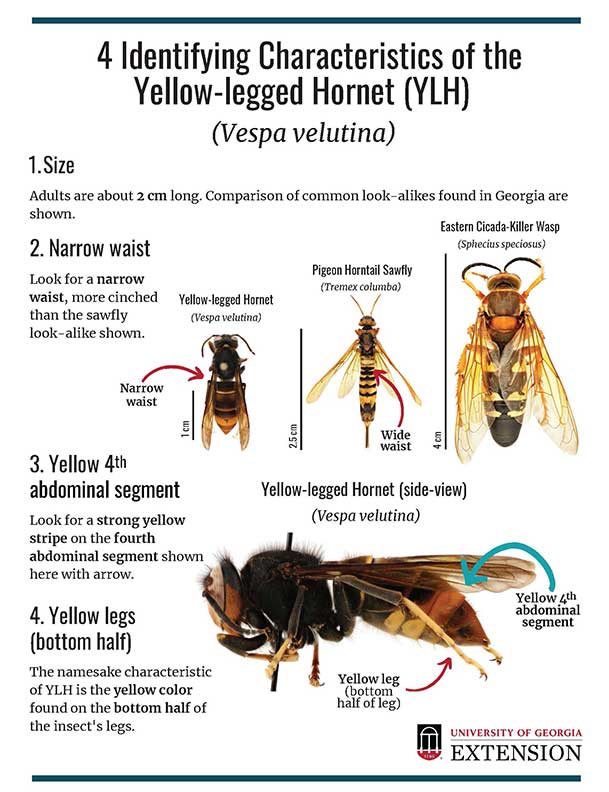
[Return to November 2023 BeeLine newsletter]
Maryland is EAS!
- Maryland is EAS!
Check out this cool promotional video from the Maryland EAS 2024, with special thanks to MSBA's own Phil Frank!
EAS 2024 – Turf Valley, MD
Join us for EAS 2024 at Turf Valley Resort in Ellicott City, MD!
August 5-9, 20245-9, 2024
Think Like a Bee[Return to November 2023 BeeLine newsletter]
"My Favorite Fondant"
- My Favorite Fondant
Your mileage may vary, but mine have been chowing on this for years (with thanks to the Oregon State Beekeepers)
by Toni Burnham
We have had a dry October, with all the hopes of a Fall flow evaporating on the news that we may have a pretty cold winter, so (as a worried mother of sorts) my mind is already on emergency winter feeding. But this is how I roll most years, really,
One of my mentees and a couple of other beekeepers are going to come to my (disorderly) kitchen this Sunday and make about 200 lbs of fondant that we will split between the four of us and place on around 20 DC colonies this fall and winter. We will get this done with about two hours of cooking in two pots (and sipping, and talking bees) and everyone will go home with chunks of sugar that my bees have taken happily since 2007.
I will likely make about as much more in January.
Some of my favorite beekeeper altercations are the (goodhearted) conversations that happen around topics such as "You're an idiot to do it like that!" and "Your bees are doomed if you feed them that!" I am also well aware from recent years that I need to change up my game some. Beekeepers like Charlie Brandts and Wayne Esaias have made persuasive presentations to our club about the value of keeping just a bit of liquid food near the cluster and/or the candy as well. I would love to hear your opinion
Here's my (stolen, adapted) recipe and my process!
Ingredients
- 25 lbs White cane sugar (this is the size of the biggest bag from Costco that I can comfortably manage)
- 5 Cups water (measure this or end up with wet mush)
- 1+ Tablespoon apple cider vinegar (you don't need much)
- A teaspoon of sea salt (optional)
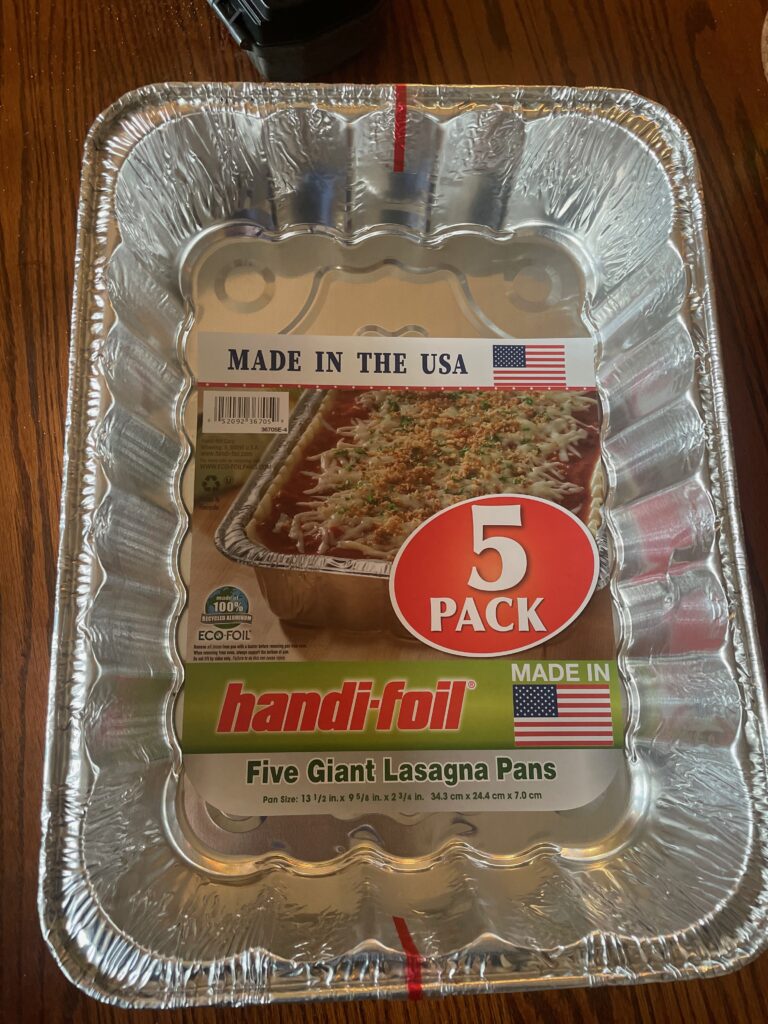
Directions
Set out your molds NOW. Hot sugar is like lava that turns into gravel. You want neither. I use cookie sheets, cake pans, bundt molds, and those aluminum pans you can buy at the grocery store for Thanksgiving or lasagna.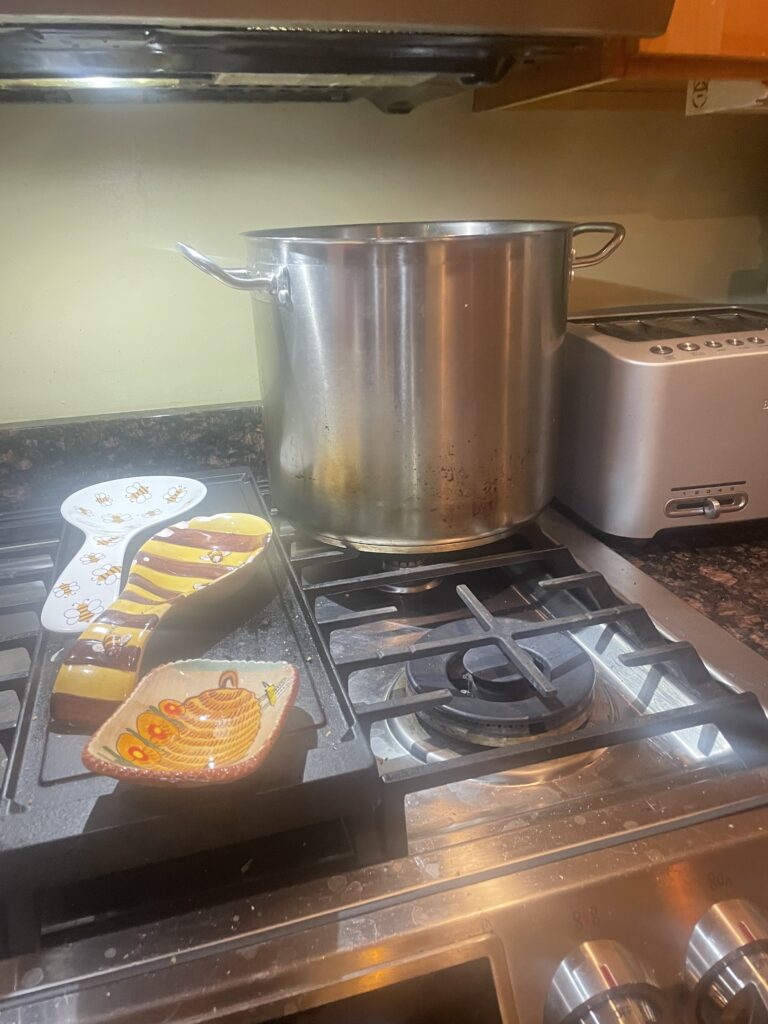
Put the water, vinegar and (optional) salt in big pot bring to a boil. When you get the contents to boil, l add half or a bit more of the sugar, stir and bring to a boil. At this point, try to make it just hot enough to boil, no more.
Once it is boiling again, add the rest of the sack, bring this to a boil again. (You know you are doing this right if the sugar you just added sorta floats and has to be convinced to mix with the rest).
The boil you are waiting for is "bubbly" boil" in the words of Andy Guest, who created this recipe. Mash it in and let it boil for 5 minutes. Sometimes I skimp on the 5 minutes and get away with it, but the candy "leaks."
Pour immediately into molds. If you let it set too long, it will come out lumpy. Please have your molds set up before you start.
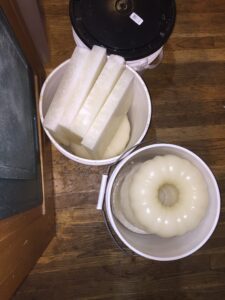
I have used all manner of molds over the years: I find it helpful to have both thin and thick candy slabs in different situations. If I am using a medium as a shim to protect the candy when I place it on the top bars, I often use a bundt pan sugar loaf with a little slab from a cookie sheet over it: I dream that the bees are able to crawl up into the center and chow down, protected.
Andy Guest added this, though I have not explored it: "One other thing I found out. If you use bakers sugar it doesn't take so long to dissolve and you don't have to boil it for 5 minutes. Bakers sugar cuts the boil time down to 3-4 minutes."
Mr. Guest talks about making shims ("rims") for the purpose of placing these fondant loaves: "It does help to have a 1/2 rim around the top of your lid. I have almost finished putting the rims around my lids. I have a 120ish to go. I tried this last year on a much smaller basis and I have also found this candy sugar helps the hives."
I find that 1/2" is way too small for the amount of fondant I hope to place on my colonies. I have bees in too many places, and I like to leave 5-10 lbs on each in case weather turns against us and I can't get to all of them in time. I get more than 5 lbs in each lasagna pan.
Notes (THEY MATTER):
HOT SUGAR BURNS INSTANTLY.
Wait for the sugar to cool to room temperature if possible. You do not need to refrigerate.
If you are using molds that are "floppy" or could flex with hot sugar in them, don't move them unless you have a cutting board or other firm surface below on which you can transport them.
If you can safely transport the molds, I often stick them outside in cold weather to speed things up.
I added the sea salt to the recipe in order to make a hotter, shorter boil and to add trace elements. I may be an idiot, really.
You can keep the sugar loaves in the aluminum pans (if you use them) until you put them on the colonies.
When I transfer the loaves to buckets, they often "leak" some fluid. I consider this positive, as the bees need water to dissolve and access the calories in the sugar.
[Return to November 2023 BeeLine newsletter]
Beekeeping News and Notes
- Beekeeping News and Notes: November 2023
Bee Informed Partnership to Shut Down

In late October, unofficial news came of the imminent shutdown of the Bee Informed Partnership due to funding issues. As many community members know, the Bee Informed Partnership was founded by Dr. Dennis vanEngelsdorp and Karen Rennich and run from the University of Maryland until recently, when it moved to Auburn University.
Projects like the United States Honey Bee Colony Loss Surveys have become a pillar of our understanding of honey bee health and beekeeping practices since 2006, moving to UMD in 2011. Many Maryland beekeepers are also active participant in the pioneering Sentinel Apiaries program.
We understand that the staff of Bee Informed are being let go, but are nonetheless working to move their data and work to other research centers before completing the shutdown. The UMD team is still determining where there are roles that staff can move to within the UMD Honey Bee Research Lab, which continues to operate.
CCBA Beekeeping Course
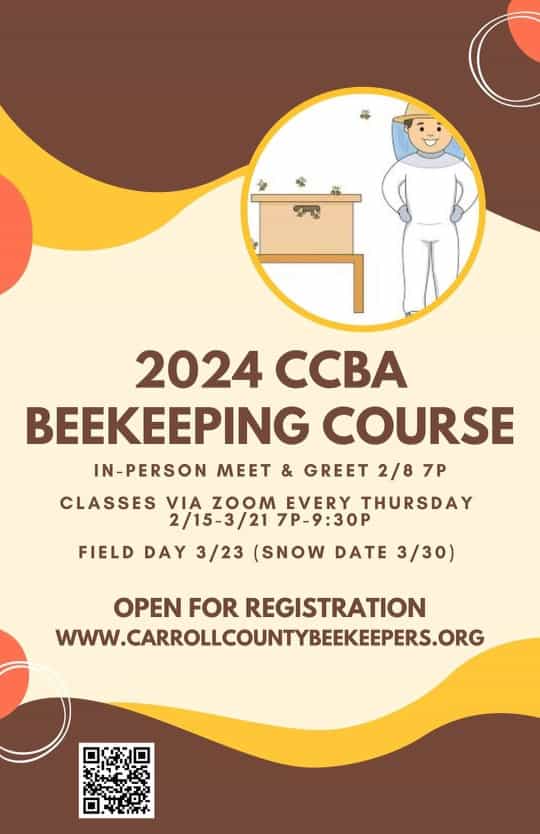
Swarm Catching Magic
A recent article by Andrew Colletti in Atlas Obscura features former MSBA keynote and beekeeping historian Dr. Gene Kritsky, discussing magic spells used during the Middle Ages to lure honey bees back into their home. Here is one (used primarily by churchmen!)
“Take [some] earth, throw it with your right hand under your right foot, and say:
‘I catch it under foot, I have found it. Lo! Earth has power against all and every being, and against malice and against mindlessness, and against the mighty tongue of man.’
And then throw dust over the bees when they swarm, and say: ‘Sit you, victory-women, settle to earth! Never must you fly wild to the wood. Be you as mindful of my welfare as each man is of his food and home.’”
The article gives a fascinating look back at medieval beekeeping as well as the usual explanation of swarm biology
Recent Paper Indicates Apis Mellifera has European Origin
Dr. Steven M. Carr of Memorial University of Newfoundland published a paper in June's Scientific Reports that asserts that existing hypotheses that Western honey bees originated in Africa or Asia is not supported when analyzing mitochondrial DNA. In fact, his work shows instead a basal origin of A. m. mellifera in Europe about 780,000 years ago, followed by expansion to Southeast Europe and Asia Minor. Eurasian bees then spread southward via the Levant into Africa . Professor Carr commented, "The accepted wisdom is that European honey bees evolved from Africa or Asia. It turns the standard picture on its head."
Pesticides a possibility? Rethink re-using that comb
A brand new study published in the October 2023 issue of Scientific Reports shows troubling impacts from re-use of frames from deadouts associated with pesticide contamination. "Re-using food resources from failed honey bee (Apis mellifera L.) colonies and their impact on colony queen rearing capacity" from Drs. Rogan Tokach, Autumn Smart, and Judy Wu-Smart of the University of Nebraska-Lincoln concludes that "colonies given pesticide-contaminated resources (including neonicotinoids) produced fewer queen cells per colony and had a lower proportion of colonies successfully raising a functional, diploid egg-laying queen." Their control group was provided with "clean" frames from deadouts that did not have pesticide exposure, and these colonies produced significantly more queen cells.
Honey Bee Pollination Behavior May Result in Less Fit Plants
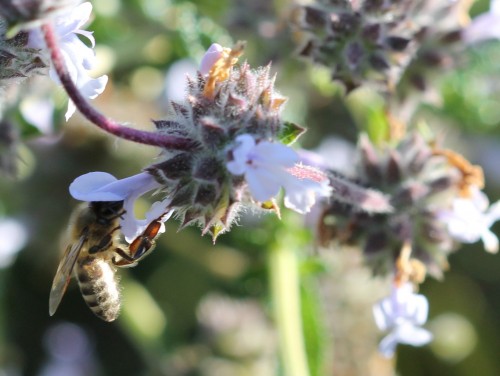
In a recent paper from the Royal Society titled "Honeybees (Apis mellifera) decrease the fitness of plants they pollinate," researchers Dillon Travis and Joshua Kohn observed the visitation behavior of Western honey bees versus native pollinators on several California floral speciesin order to gauge the quality of the pollination for plant survival and fitness. Historically, scientists have tried to judge this phenomenon by size -- basically, the number of pollen grains being transferred. In this study, however, the scientists propose that the number of blooms visited on each flower in a single visit may play an important role. Honey bees tend to work many blooms on the same plant before moving on, resulting in what Travis and Kohn theorize may be substantial self-pollination rather than cross-pollination between different members of the same species. Native pollinators are more likely to visit single blooms and then move on. Their conclusion: "Offspring produced after honeybee pollination have similar fitness to those resulting from hand self-pollination and both are far less fit than those produced after pollination by native insects or by cross-pollination."
Penn State Study: Organically Managed Colonies are Just as Healthy, Productive
A team led by Robin Underwood of Penn State University published the results of a longitudinal study in Scientific Reports this Spring, finding that honey bee colonies managed using organic methods were as healthy and productive as those managed in conventional systems, while avoiding the use of synthetic pesticides to control pests and pathogens inside the hive. To evaluate the effectiveness of various beekeeping approaches, the researchers studied nearly 300 honey bee colonies located on eight certified organic farms — six in Pennsylvania and two in West Virginia. The research team developed study protocols in collaboration with 30 experienced beekeepers grouped in three broad categories: conventional, chemical free, and organic. Their results show that organic and conventional management systems both increased winter survival by more than 180% compared to chemical-free management. Organic and conventional management also increased total honey production across three years by 118% and 102%, respectively. Organic and conventional management systems did not differ significantly in survival or honey production.
[Return to November 2023 BeeLine newsletter]
Beekeepers Gallery
- Beekeeper’s Gallery
Wanted: your beekeeping-themed photos and artwork!
Have you taken a beekeeping photo or created a pollinator image that the world should see? Share it here!
Each of these contributors gets credit and owns all rights to their images!
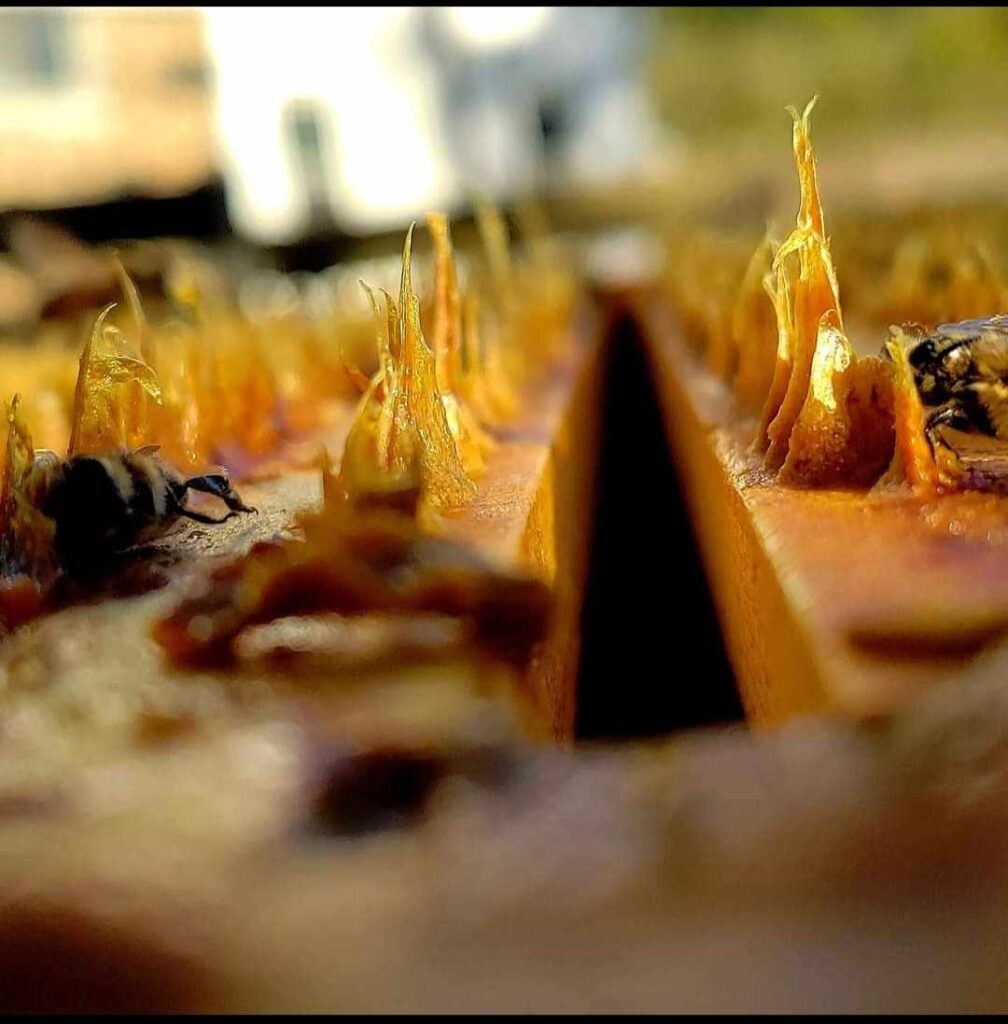
Propolis from Emily Gannon
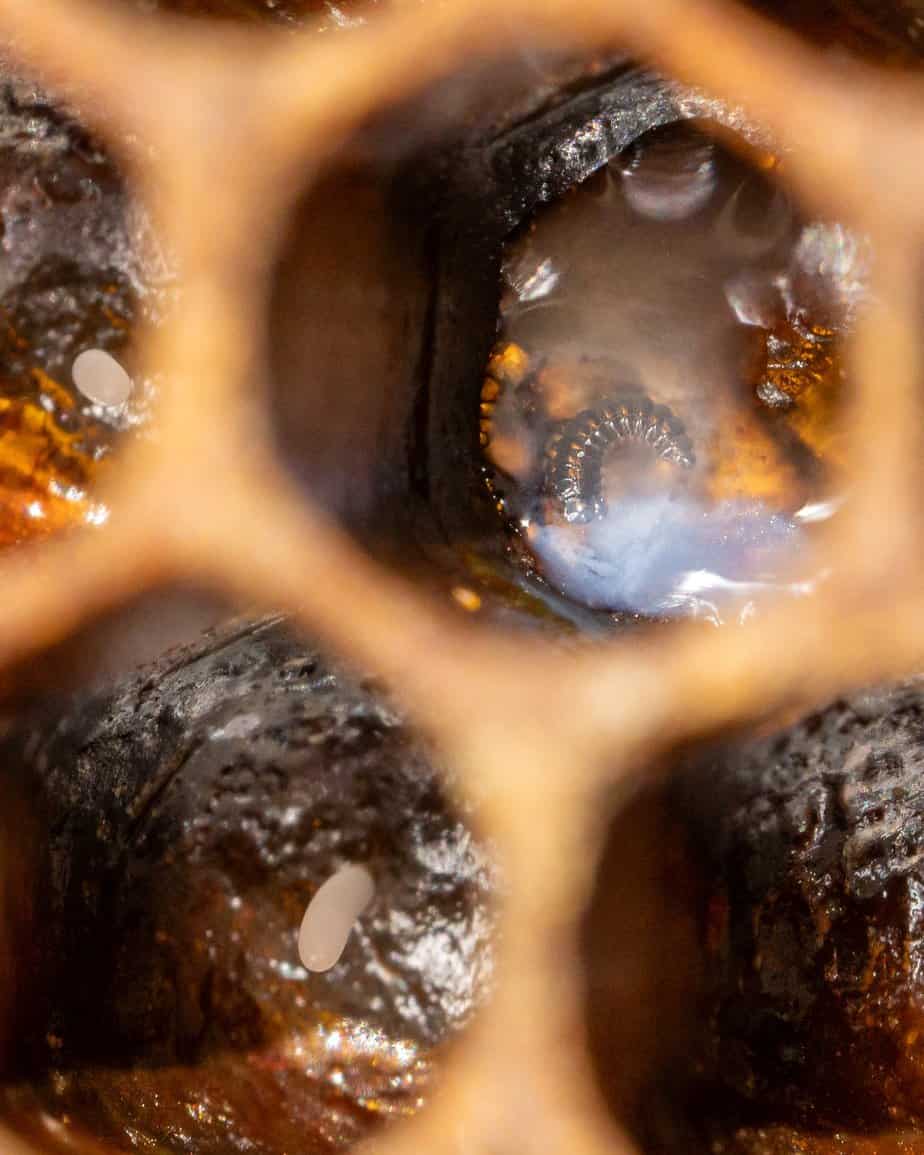
"New Beginnings" from Matthew Gagle
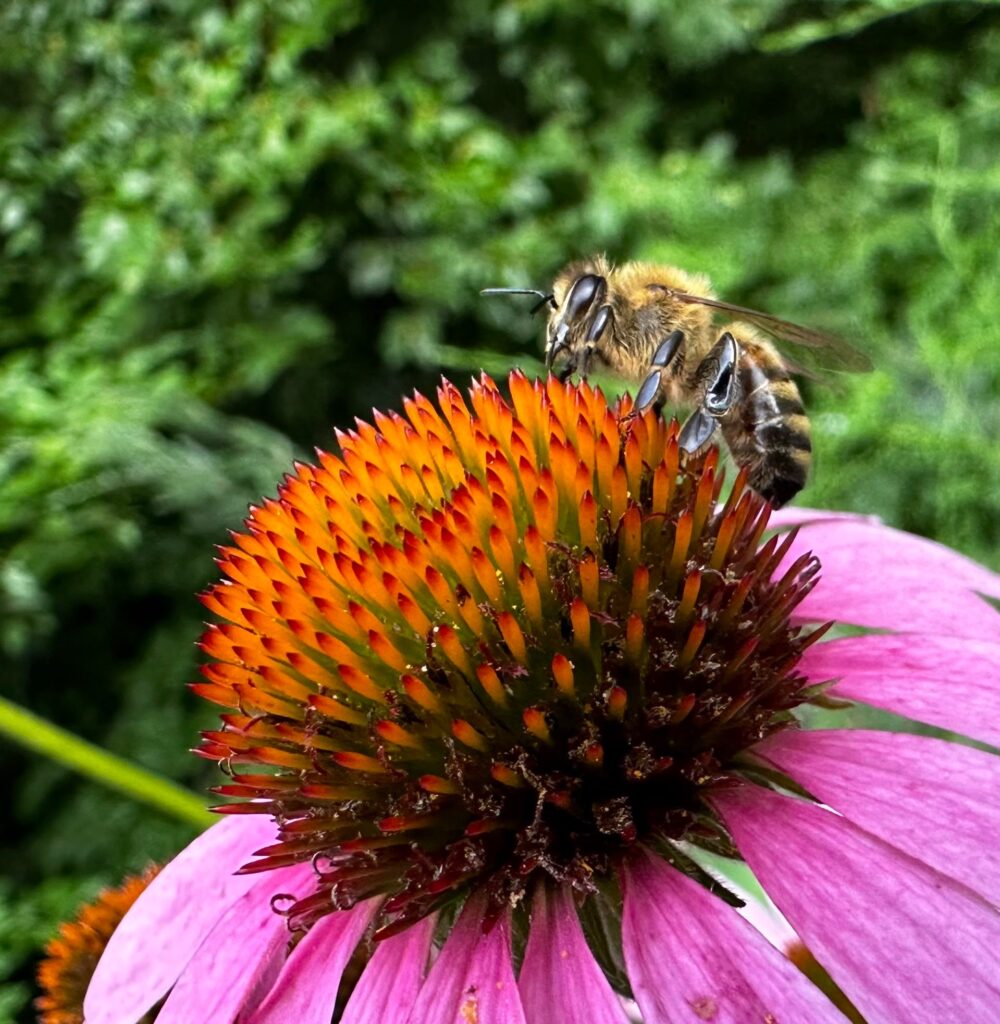
Echinacea receives a visit, from Phil Frank
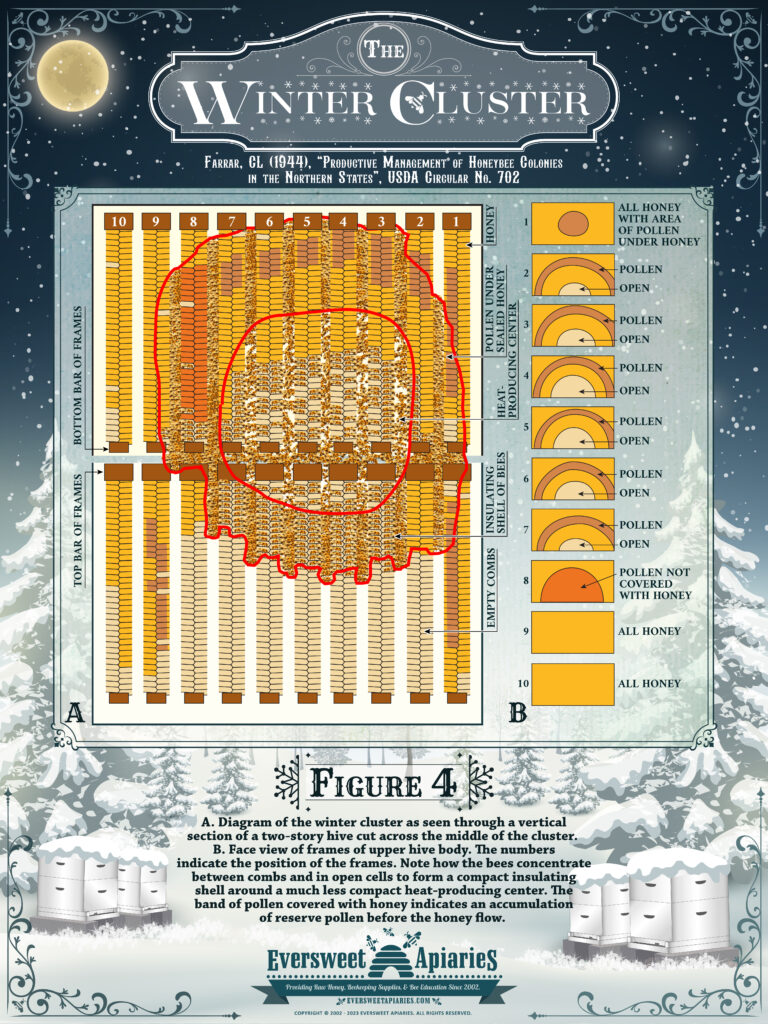
"The Winter Cluster" from Jennifer King of Eversweet Apiaries
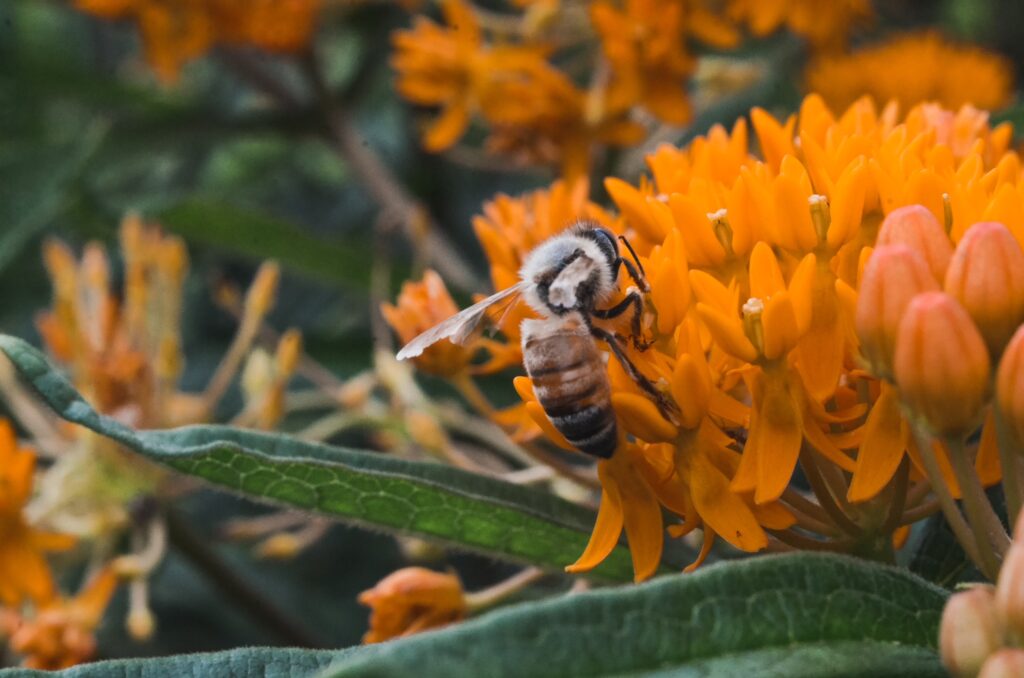
From Stephanie Liller: an aging forager
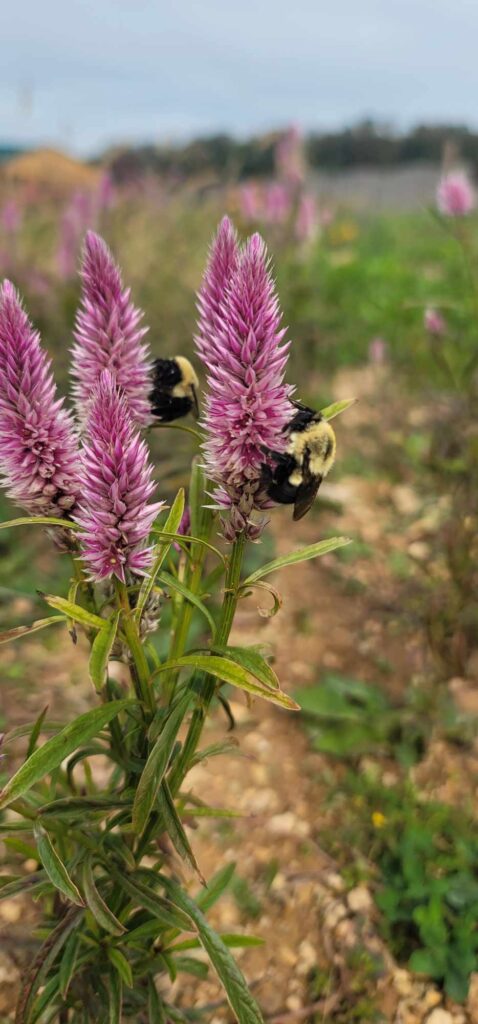
Bumblebees from Monica Schmitt of Mission Beelieve
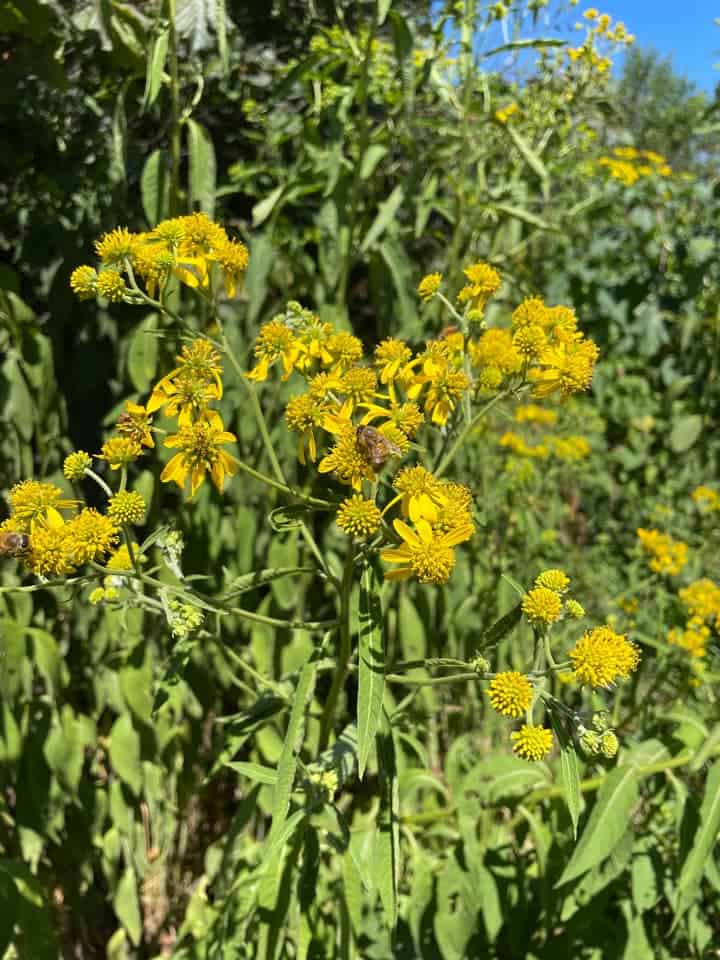
From McIntyre Bee Farm: "Here’s a great honey producer Wingstem or Golden honey plant . It’s a fall producer for honeybees and all pollinators and they seed themselves for next year."
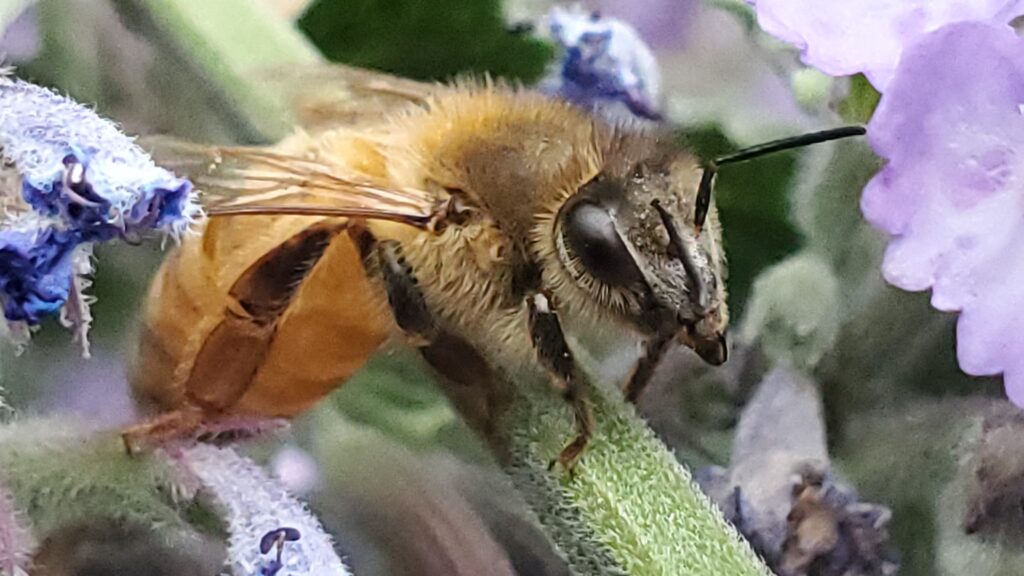
Close Up from Phil Frank (you can see her toes!)
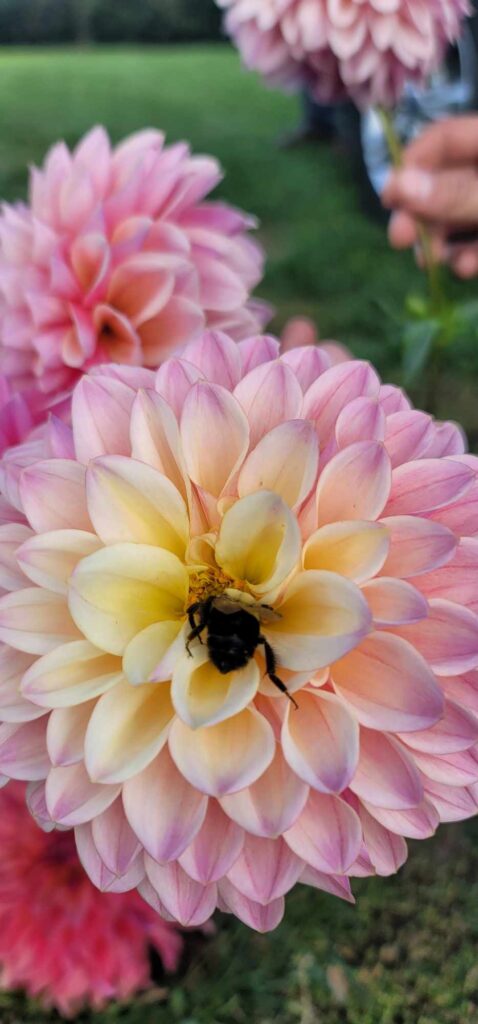
A bumblebutt from Monica Schmitt
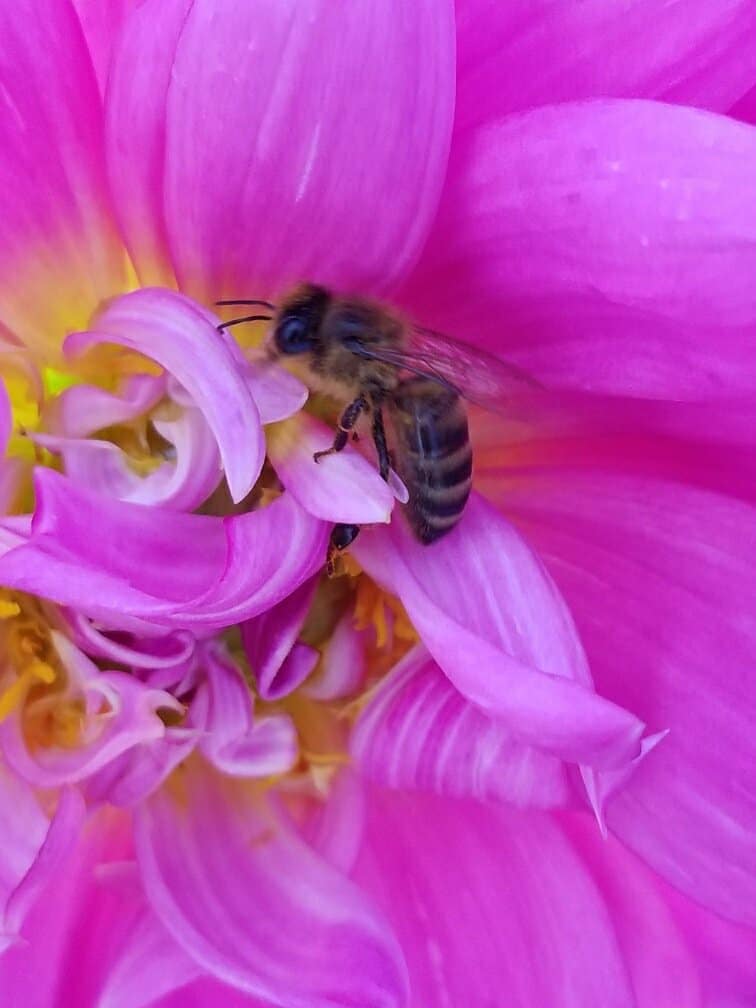
From Valerie Wampler: "My two loves are dahlias and honey bees."
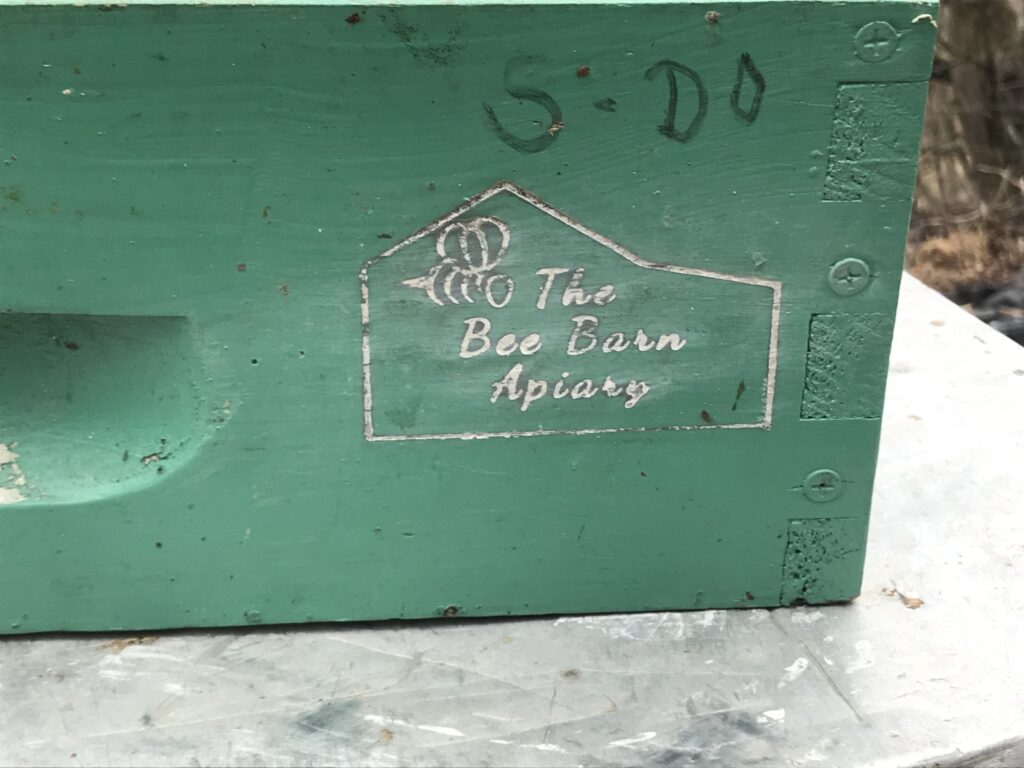
Branded box coming in for the season, from Ben Cooper
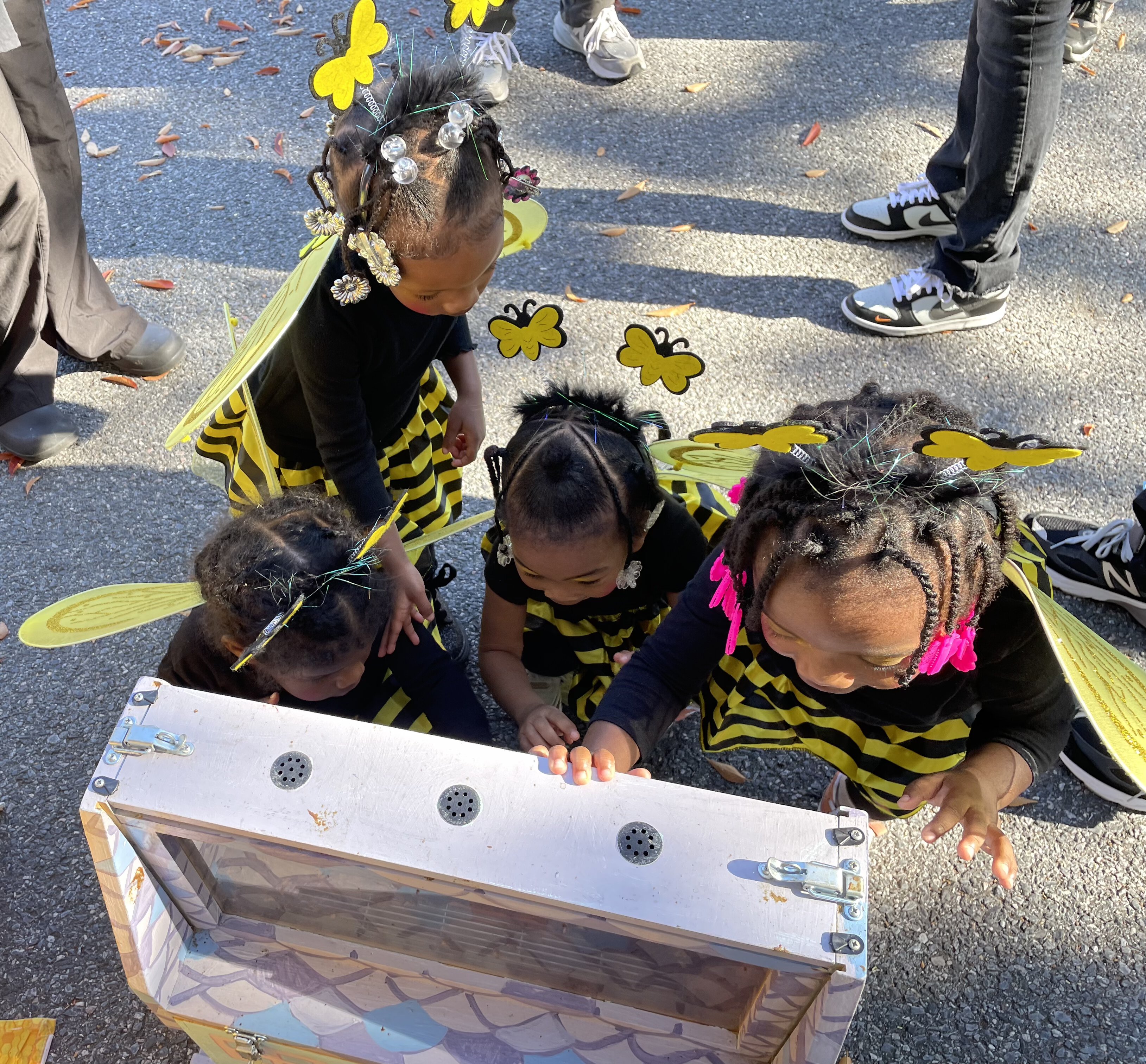
Beautiful Baby Bumbles at the Obs Hive from Toni Burnham
[Return to November 2023 BeeLine newsletter]

